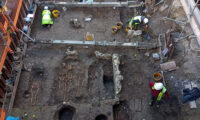 The remains of more than 240 individuals buried in the cemetery of a lost 13th century friary have been discovered under a former department store in Haverfordwest, Pembrokeshire, Wales. More than 100 of them are children, and most of them infants under the age of four. The bodies were unearthed at the site of the onetime Ocky Whites department store, closed since 2013 and now slated for redevelopment. The large number of graves identifies the site as the burial ground of the friary of St. Saviours.
The remains of more than 240 individuals buried in the cemetery of a lost 13th century friary have been discovered under a former department store in Haverfordwest, Pembrokeshire, Wales. More than 100 of them are children, and most of them infants under the age of four. The bodies were unearthed at the site of the onetime Ocky Whites department store, closed since 2013 and now slated for redevelopment. The large number of graves identifies the site as the burial ground of the friary of St. Saviours.
The first record of the Dominican friary of St. Saviours in Haverfordwest dates to 1246 when Henry III granted the friars 10 marks to build a church. Ten years later, they were granted another 15 marks to move their community to a new site where they built a larger friary. St. Saviors received frequent donations and bequests over the centuries, but as happened with many monastic communities, by the early 16th century its revenues were slipping. It turned to leasing out its lands in 1526, and in 1535 took in tenants.
The friary met its final end in the second round of dissolutions of the monasteries. More modest friaries like St. Saviors hadn’t been targeted in the forced visitations, confiscations and formal dissolutions that demolished monasticism in England and Wales. By 1538, the focus was on getting the remaining communities to voluntarily (?) surrender their houses to the Crown. The eight remaining friars at St. Saviors did so on September 2nd, 1538, although the last signatory seems to have changed his mind because the name is smeared off the document.
St. Saviours disappeared from the landscape, leaving its traces only on names like Friars Lane and the Friars Vault pub. There were no historic records noting its exact location and the knowledge was lost over time. The discovery of the burial ground has begun to unravel the mystery.
Site supervisor Andrew Shobbrook, from Dyfed Archaeological Trust, described the priory as a significant complex of buildings with dormitories, scriptoriums – rooms devoted to writing and manuscripts – stables and a hospital.
“It’s quite a prestigious place to be buried. You have a range of people, from the wealthy to general townsfolk,” he said. It is believed that the graveyard could have been used until the early 18th Century. […]
Some of the remains have been found with head injuries, consistent with having been in battle, and the wounds could have been caused by arrows or musket balls, according to Mr Shobbrook.
One theory is that the victims could date from an attack led by Owain Glyndŵr, who was the last native Welsh person to hold the title Prince of Wales. It was a joint assault by Welsh and French forces, who had united to battle English occupation of Wales.
“We know that the town was besieged in 1405 by Owain Glyndŵr and they could be victims of that conflict,” said Mr Shobbrook.
The skeletal remains are being cleaned and analyzed before reburial in consecrated ground near the find site.